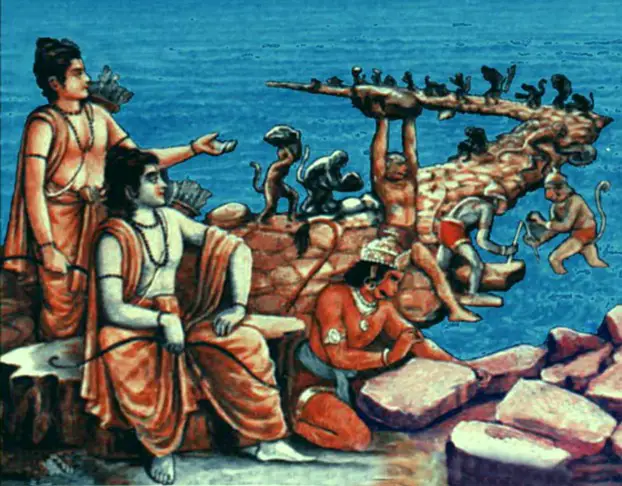The Ramayana, a foundational epic poem in Hinduism, narrates the life of Prince Rama and his epic journey. While its historicity remains a subject of ongoing debate, archaeological discoveries offer intriguing glimpses into potential connections between the text and the real world.
Tracing Rama’s Footsteps:
- Dandakaranya: The Ramayana describes Rama’s exile to Dandakaranya, a vast forest. While its precise location remains elusive, some scholars posit its association with regions in present-day Madhya Pradesh, central India. Interestingly, archaeological excavations in this area have unearthed settlements dating back to the period corresponding with the Ramayana’s estimated timeframe. Additionally, the town of Panchavati in India is traditionally believed to be the location where Rama, Sita, and Lakshmana resided during their exile.
- Rama Setu: A pivotal element of the Ramayana is the bridge built by Rama’s monkey army to Lanka (identified with Sri Lanka). Modern satellite imagery reveals a chain of naturally occurring shallow formations in the Palk Strait, also known as Adam’s Bridge or Rama Setu. The debate regarding its origin, whether entirely natural or partially man-made, continues to spark scientific discourse.
- Ayodhya: Considered Rama’s birthplace, Ayodhya in Uttar Pradesh, India, has witnessed continuous habitation dating back to 1200 BCE as revealed by archaeological excavations. While not a definitive confirmation of Rama’s existence, these findings highlight the region’s long and significant history, potentially aligning with the geographical descriptions in the Ramayana. The presence of the Sarayu River, a prominent feature in the epic, flowing near Ayodhya further strengthens this potential connection.
- Sarayu River: The Ramayana prominently features the Sarayu River. Interestingly, the modern-day Sarayu flows near Ayodhya, potentially aligning with the geographical descriptions in the text.
- Rameswaram: The Ramayana narrates that Rama, before building the bridge to Lanka, established a Shiva lingam at Rameswaram. The island of Rameswaram, off the coast of Tamil Nadu, India, is a significant pilgrimage site for Hindus and houses the Ramanathaswamy Temple, a sprawling complex dedicated to Lord Shiva. While the temple’s current structure dates to a much later period, the presence of this revered pilgrimage site adds another layer to the potential link between the Ramayana and geographical locations.
- Other Sites: Locations like Kishkindha (mentioned as the monkey kingdom) and Lanka have been linked to present-day sites in India and Sri Lanka. However, these connections are often based on tradition and interpretation, lacking definitive archaeological proof.
Challenges and Considerations:
It’s crucial to acknowledge the limitations of interpreting archaeological evidence. While these discoveries hint at a possible historical basis for some elements of the Ramayana, they don’t definitively prove the events as narrated in the epic.
- Dating: The Ramayana’s timeframe is a point of contention, with estimates ranging from the 7th millennium BCE to the 2nd millennium BCE. Dating archaeological finds doesn’t always provide a perfect match for the epic’s timeline.
- Oral Tradition: The Ramayana was likely passed down orally for centuries before being written down. Oral transmission can lead to embellishments and alterations over time, blurring the lines between historical fact and embellished mythology.
Quiz on Ramayana – Reading Suggestion
According to Wikipedia, the oldest parts of the Sanskrit epic Ramayana are estimated to date from the 7th century BCE, and later parts may date from as late as the 3rd century CE. The epic was written by Rishi Valmiki, a legendary poet who is also known as Ādi Kavi, the first poet. The oldest known version of the Ramayana is an 8th century BC epic poem with over 24,000 couplets divided into seven chapters, or kandas. However, Valmiki attributed the work to another sage, Narada, and did not claim it as his own.
Conclusion:
The Ramayana’s true significance lies in its enduring cultural and religious influence. Whether purely mythical or with a basis in historical reality, it continues to inspire millions and remains a cornerstone of Hindu tradition.
